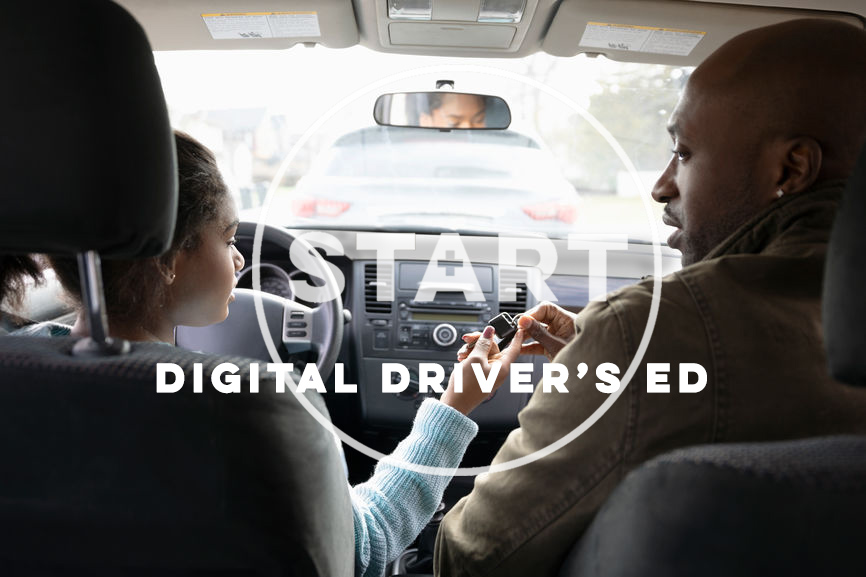
For most of us, the first time we got behind the wheel is a vivid memory. Whether it was in a parking lot, or a quiet side street—it’s easy to remember both where it happened and who we were with. The one thing we all had in common? We weren’t alone—there was a mentor sitting next to us, painstakingly guiding us through a process where we were gradually given more responsibility. This generous adult logged many hours riding in the passenger seat, helping us learn and grow as we encountered road hazards, detours, and reckless drivers who swerved outside the yellow lines. For some mentors more than others, this was exhausting work—but it was worth it. The result? Confident, responsible drivers who could navigate the roads as safely as possible.
At START, we want to help parents take a similar approach when helping kids navigate social media and smartphones. We call this process “Ride. Practice. Drive.” It’s a simple, but powerful tool you can pull out the next time your child or teen asks for a new app or smart device. Here’s how it works.
First, with any new digital experience, your kid starts by buckling up for a backseat ride. We all did this for years watching our parents drive – learning the landmarks, what to do at red, yellow, and green lights, the meaning of the numbers on a speed limit sign…and the color of police sirens when you ignore it. Similarly, our kids are learning about tech use from birth. They see what captures our attention and in what situations we step away from the phone or are absorbed in it. In the “riding backseat” stage, it’s important to establish your family values, and do your best to model the healthy tech habits you want your child to one day have. Need help knowing where to start? Check out our Rules of Thumb.
When it comes time to let your kids get behind the wheel and practice, get ready to log many hours in the passenger seat, doing the thrilling but exhausting work of coaching your student driver through whatever potholes and fender-benders come their way. In this learner’s permit phase, be sure to start with strong limits, and release them slowly. What does this look like digitally? Privacy settings should be high. Locations turned off. Passwords shared with parents, number of friends limited, and posts approved. Consider downloading the app, or playing with the device yourself–and participating in the experience so you discover what types of hazards they might come across, and can coach them through it.
One note: it can be especially hard to train your kids when you don’t have any personal experience with the social media app or digital device at hand…and can feel more like training them to pilot a helicopter than drive a car. But don’t give up! You have the most powerful tool available—a willingness to talk them through whatever comes their way. Accidents are bound to happen, so don’t freak out when your child or teen encounters emergencies. Let them know you are safe harbor, and they can come to you with anything. Assure them you will learn—together—how to handle sticky situations that you encounter.
At some point in your learner’s permit phase, you’ll begin to feel that you can trust your child to drive in a safe, savvy way —making smart, healthy choices as they navigate their own app or device use. At this point, it’s okay to give them a little space and let them merge into traffic. Your goal is to move into your role as “Roadside Assistance”—a tried and true guide they can call for help.
Ride. Practice. Drive. is a great tool to use anytime you introduce an individual app or product, but it’s also a helpful framework to answer every parent’s broader question, “What age should I give my kid a smartphone?” Before you jump into the world of smartphones, consider starting with a device that is simple and limited—like a watch or “dumbphone.” Allow them to practice texting with a handful of loved ones before advancing on to group texting, which can be like an onion—layer after layer of potential challenges. As they prove that they have mastered one digital driving skill, trust them to try out an even harder one. Eventually, you will feel confident that they are ready to try out a smartphone, stripped down to limit its features. It will take a lot of time and energy to mentor your smartphone driver through the learner’s permit phase, but take heart! Your time in the passenger seat won’t last forever. You are heading somewhere with this training process: At some point before college, they should be driving their smartphones independently. Sure they will still bump curbs or get in accidents, but hopefully they can handle most unhealthy situations on their own—maybe with an occasional call home for advice.
Ready to give it a spin? Keep your eyes out for some exciting new tools coming soon that will help you train your child to Ride. Practice. Drive. responsibly on two of the busiest digital highways for Gen Z: Snapchat and TikTok.